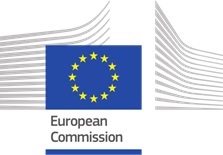4th EU-JAV Newsletter April 2021
Welcome to the fourth JAV newsletter!
‘Dear Partner,
Welcome to our latest newsletter, the fourth of the project, all of which we hope have helped to keep you updated on what kept us busy and provided information on EU-JAV advances.
We hope that in spite of these last months of pandemic, you still find time for essential projects, regarding Covid-19 or other topics, and make sense of all of this.
Have a good week and enjoy your reading!’
Introduction by Olivier Epaulard, Coordinator of the Joint Action, INSERM
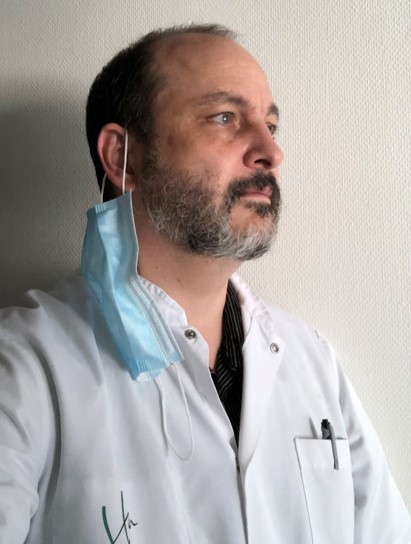
Dear all,
Covid-19 pandemic has put us all under pressure, forcing us to find solutions to predict curves, contain transmission, cope with many cases, or prevent new ones. Vaccines will finally be the solution of this nightmare; it is hard not to marvel how, again, a viral disaster will be controlled not by therapy, but by immunization. It is also extraordinary to see how scientific experiments that only a minority of people were aware of, conducted in the last 10 years, have finally allowed the elaboration of several highly efficient vaccines in a uniquely short amount of time. Finally, the last 15 months have illustrated how much the optimal scale to collectively solve such a crisis is not national, but continental: regarding vaccine supply or production (to fairly allocate doses in all countries), vaccine strategy (to act consistently to reach an optimal vaccine coverage in key populations), transborder vaccine actions (to set up rapidly a multinational vaccine campaign in case of transborder viral transmission hot-spot), vaccine pass (to set a useful and simple international device, accepted by all), regarding variant detection and epidemiology, regarding vaccine hesitation (e.g., to address both misinformation and misconception), regarding global vaccine solidarity (to ensure that no country will stay unvaccinated for economic consideration, putting its own population at risk, and consequently all other countries: with a mutation-prone virus, no one is safe until everybody is): for all these challenges, the optimal level to act efficiently is not the country, but Europe.
We regard EU-JAV progresses, detailed in this newsletter, as demonstrating this same, simple, obvious idea: regarding vaccination, Europe is the ideal scale.
Thank you for following us!
Yours,
Olivier Epaulard
Building Policies for Vaccination
by Christine Berling, Antonietta Filia, Greet Hendrickx, Magid Herida, Jose Tuells and Wendy Yared

Task 4.2 Develop an “integration into national policies and sustainability" plan
‘The first proposed plan strives towards guiding Member States to integrate the EU-JAV outcomes into national policies through operational measures and to ensure the long-term sustainability of these measures, through relevant sustainable EU governance.
The second version of the plan has been submitted. It describes some of the EU-JAV concrete outputs and proposes to apportion theses outcomes into two groups: those to be integrated into national policies and those that should be sustained at EU level. It takes stock of the progress of the EU-JAV until December 2020. The final version is being working on.’
Task 4.3: Piloting of selected actions identified in the “integration into national policies & sustainability” plan
‘The European health student survey has been finalised, including responses from medical, nurse and pharmacy students across Europe, with thanks to the active engagement of student organisations EMSA, EPSA and ENSA participating in the Coalition for Vaccination. It investigates the time spent on vaccinology in the curriculum of future HCPs and their confidence in vaccines. Moreover, a survey called “Vaccine Training Barometer” has been launched (the second round in Flanders, and the first round in Spain are being finalised). With this online survey we are investigating the need for training in HCPs at that time in the surveyed population.
Preliminary results of both studies confirm the need to revise the curriculum of future HCPs, the high need for additional education material, and a strong willingness to participate in training activities amongst practicing HCPs. Reports summarizing the outcome of both surveys are being prepared. Based on these results, we are also tailoring the vaccination module/curriculum for in-service as well as future HCP. These vaccination modules will be used as a basis for the development of train the trainers’ package in a recently started EU project IMMUNION.’
Task 4.3.2 Explore the possibility to establish an appropriate cooperation structure between EU/EEA NITAGs
‘A survey was performed among NITAG chairs/secretariats to better understand the functioning of NITAGs in EU/EEA and EU-JAV countries, their budgets and costs, how topics and research questions are defined, and collect details on collaborations with other NITAGS. Drafting of the report is on going.’
· Task 4.3.2.1 Provide an overview about the evidence-base of national immunization programs
‘A cross-sectional pilot survey is being conducted in France, The Netherlands, Italy and Spain during the first quarter of 2021 to better understand how decisions and recommendations are made regarding specific vaccines. The results of this pilot study will be used to improve the questionnaire before launching a wider survey during the second half of 2021.’
Task 4.3.3: Develop an effective strategy of communication towards European young people on vaccine
‘The Association of European Cancer Leagues (ECL) is working towards the development of a communication strategy that would be effective in raising awareness on vaccination among European youth. The strategy is being developed with the valuable inputs of ECL Youth Ambassadors network, a group of young cancer prevention advocates. ECL has organised two editions of “ECL Youth Competitions". The first edition was held is 2019 and the second one is taking place this year.
The 2021 Competition aims to raise awareness among young people residing within the WHO European Region about the importance of human papillomavirus (HPV) vaccination for cancer prevention as well as the importance of promoting the uptake of HPV vaccination.
Young people under 26 years old are encouraged to create visual designs and short videos for the ‘Creativity Competition’ or come up with policy recommendations for the ‘Case Study Competition’for a chance of winning prizes up to a value of € 1000!
The deadline for submissions is 30 April 2021 (25:59 CET). Shortlisted entries will be disseminated during the European Week Against Cancer (25-31 May 2021).’
IT systems for vaccination surveillance
by Hanne-Dorthe Emborg, Tyra Grove-Krause and Srdan Golubovic

‘An R-package (a development of the statistic software R) was developed as a tool to do timely and standardised estimations of measles-containing vaccines (MCV) coverage within and between countries and to identify immunity gaps at national and regional level. A standardised population and vaccination file are required to use the R-package. This tool visualises very clearly that the differences in recommend age of vaccination result in immunisation gaps between countries.’
Figure A. Comparing MCV dose 1 coverage in the 2019 birth cohort in Finland, The Netherlands and Denmark, start December 2020 (screenshots from the R-package)
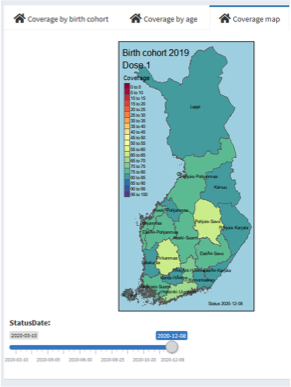

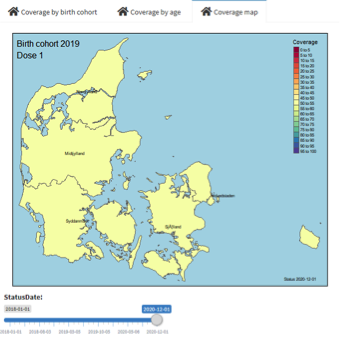
|
Figure 16. Comparing MCV dose 2 coverage in birth cohorts 2016 in Finland, The Netherlands and Denmark, start December 2020 (screenshots from the R-package) |
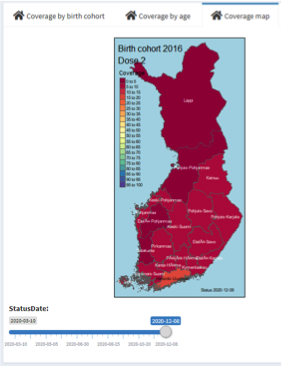
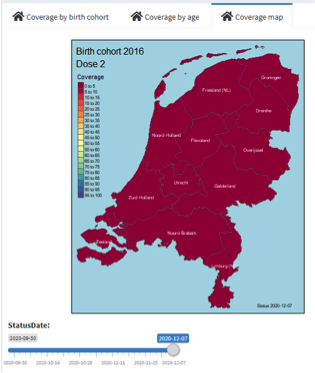
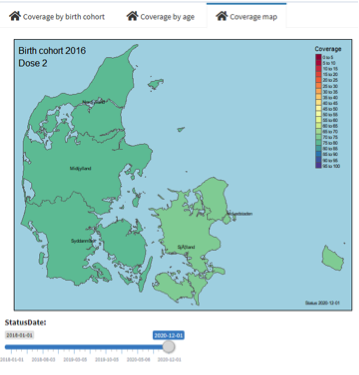
Vaccine Supply and Preparedness
by Antonietta Filia and Karianne Johansen
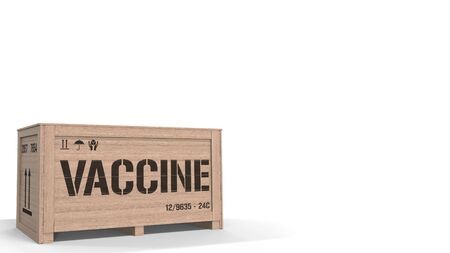
Task 6.1: Mapping vaccine needs and demand.
‘A report on vaccine shortages in Europe and responses at national and European levels in the recent years has been published and is available on the website. In October 2020, the results of our survey were presented, as an oral presentation at the 16th World Congress of Public Health.
We are currently finalizing the report on analyse and evaluation of the local financing mechanisms to ensure sustainable purchase and stock of vaccines. It will include a narrative review on vaccine procurement, including pros and cons of centralised/joint procurement versus self-procurement, and the results of a survey on financial mechanisms for vaccine procurement, conducted in 2020, amongst persons in charge of national/subnational immunisation programmes or of vaccine supply/procurement in EU/EEA and consortium (EU-JAV) Member States (MS).’
Vaccines for the Future
by Karianne Johansen, Marie-Paule Kieny and Jean-Daniel Lelièvre

Task 7.1: Priorities for vaccine research and development
‘After the first works we had conducted on vaccine research in general, research questions related to vaccination against COVID-19 have been collected this last year.These questions will be analysed by the team and submitted to the prioritization process to determine which might be considered as top priority in the European context. It will be then added to the previous questions related to vaccine research in general.’
Building Trust in Vaccination
by Antonietta Filia, Francesco Gesualdo, Hanna Nohynek and Jonas Sivela
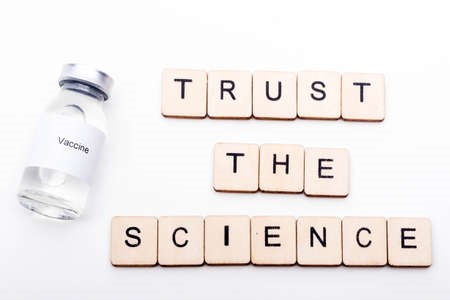
Task 8.1: Barriers and enablers behind suboptimal vaccination coverage and 8.2: Support for effective programme implementation
‘We have finalized data gathering among stakeholders looking at the perceived situation concerning vaccine hesitancy and uptake – and also practices that are known to maintain good vaccination coverage. Our data analysis and work with the final report continues, now including also stakeholder data.’
Task 8.3: Monitoring real time public vaccine confidence through social media and promote healthy behaviour through the web
‘We have created a social media-monitoring platform for this work package; it already shows some data. As expected, the Twitter conversation on vaccines has increased in recent months. This can be seen in the Figure below, showing the trends of vaccine-related tweets (originating from Italy, France and Spain, respectively), identified by our platform from 30 September 2020 to 31 March 2021. Differences in the three trends might be due to specific interests or concerns circulating in the three countries, and also to a different use of Twitter by the population.
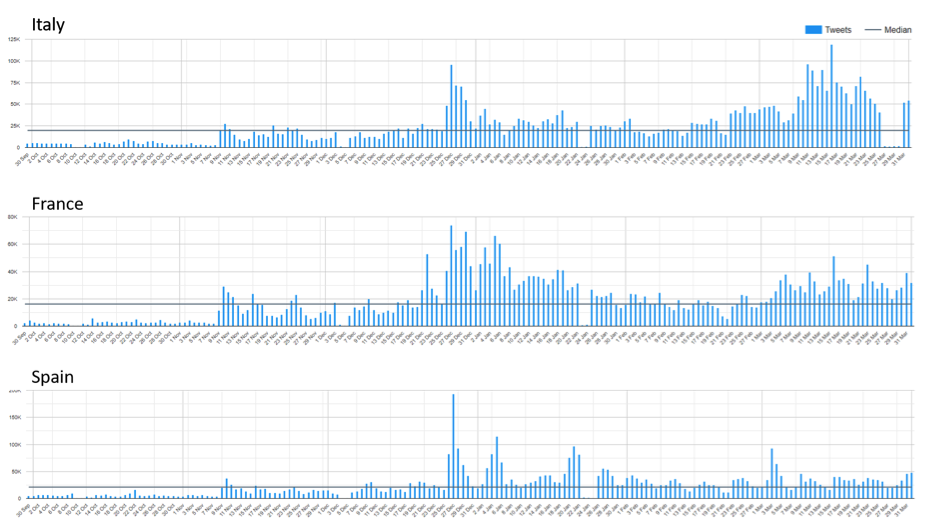
We are working on creating an algorithm for the automatic classification of vaccine stance of the tweets. The algorithm is based on artificial intelligence techniques and will allow us to display on the platform a weekly estimation of the stance of vaccine-related tweets.
We are also developing and validating new, complex keyword filters for identifying and estimating the proportion of tweets on two specific topics related to COVID-19 vaccines: safety and vaccination strategy.’
EU-JAV
European Joint Action on Vaccination
This joint action was co-funded by the European Union’s Health Programme (2014-2020) under Grant Agreement no. 801495
